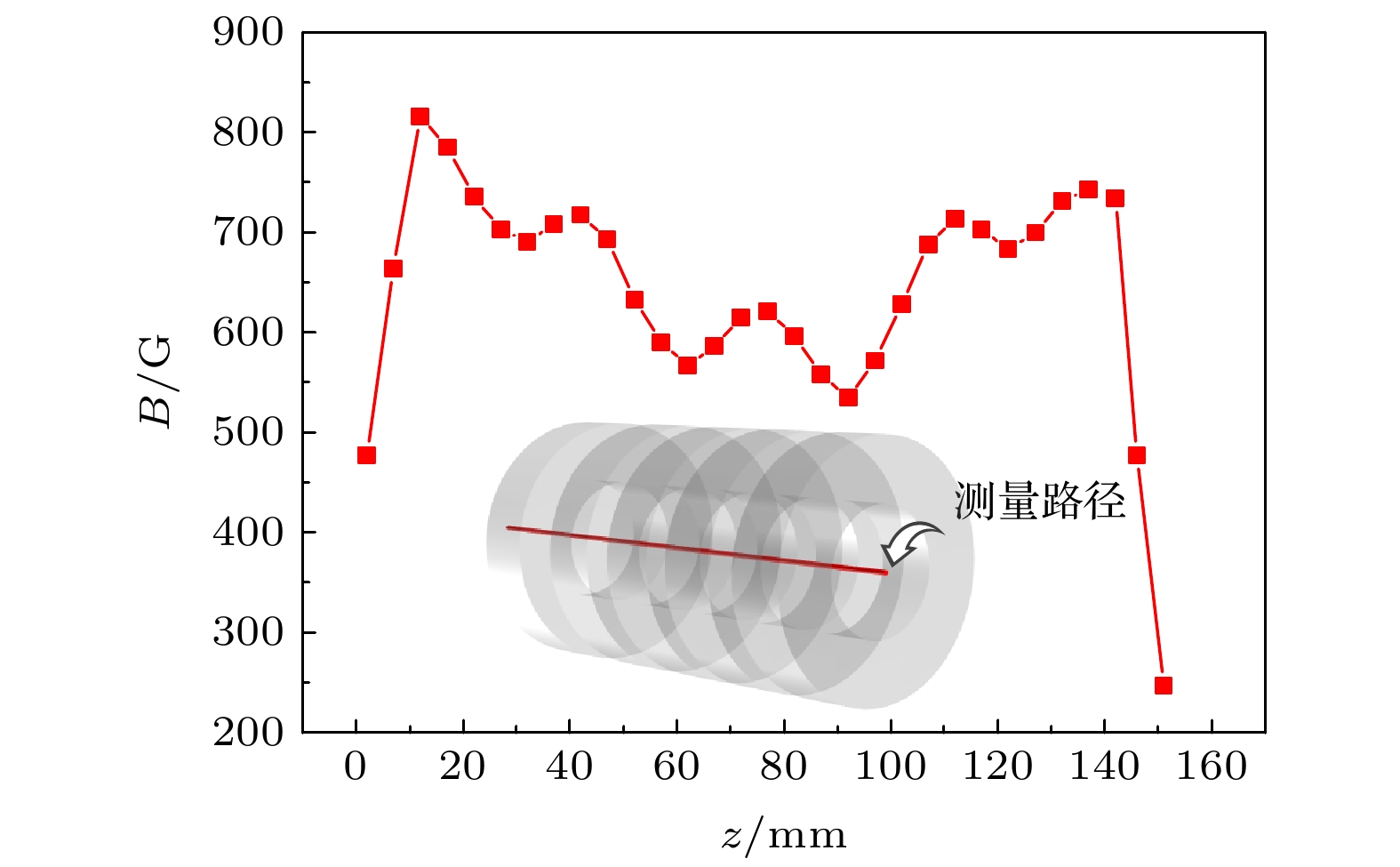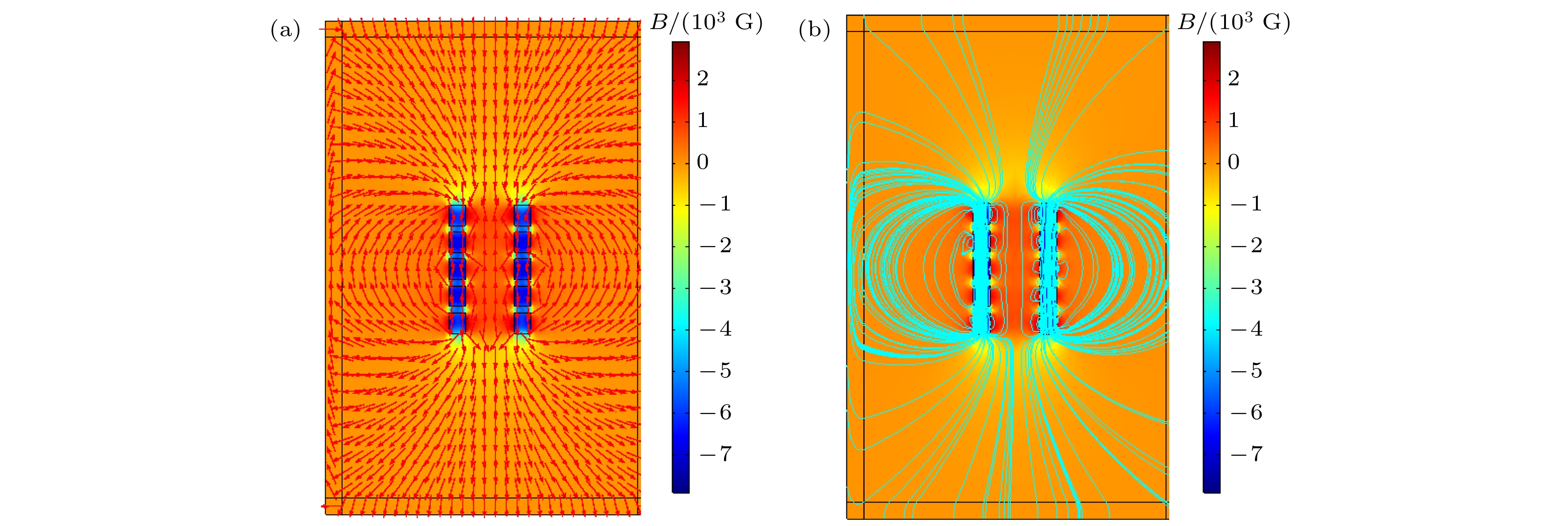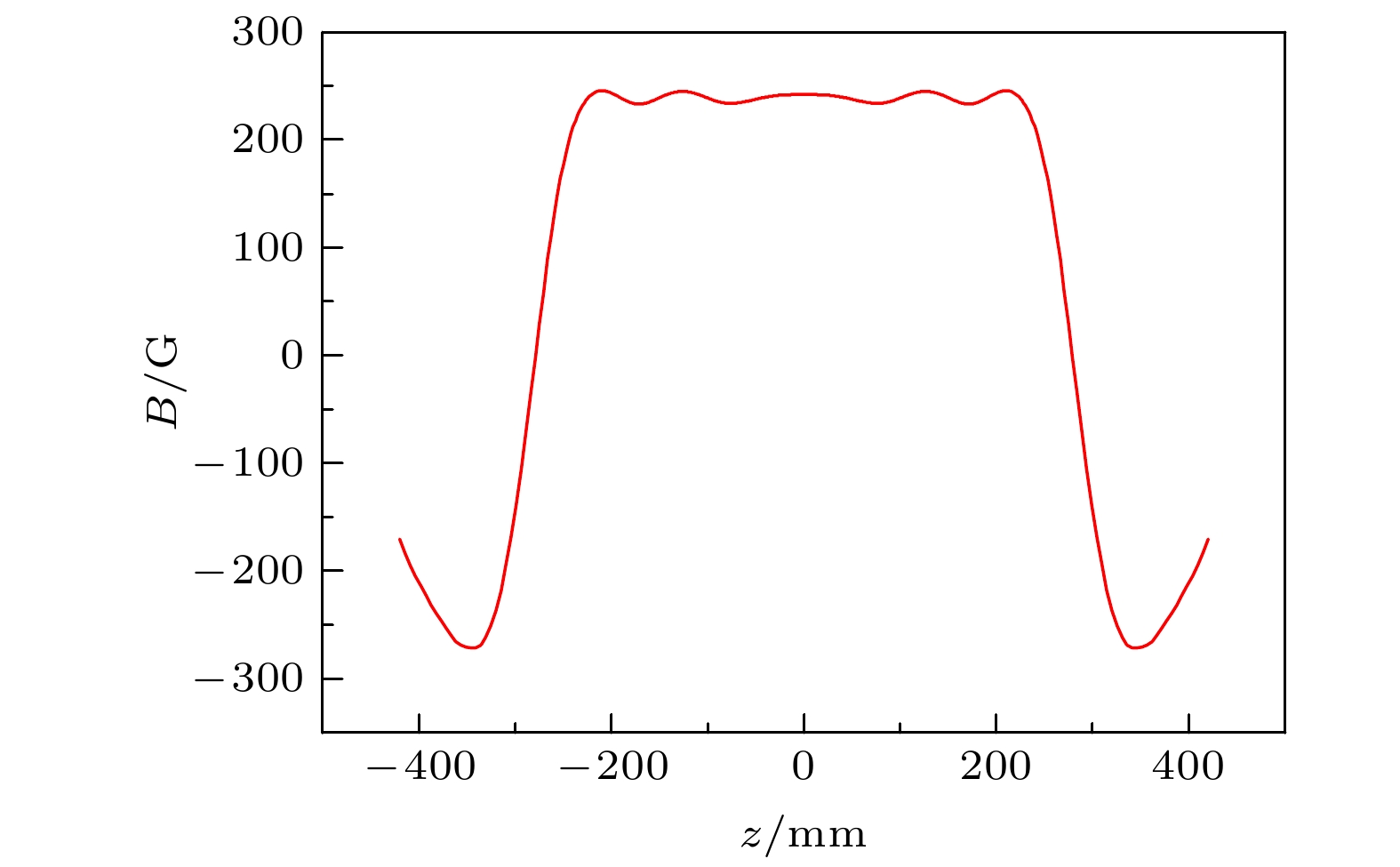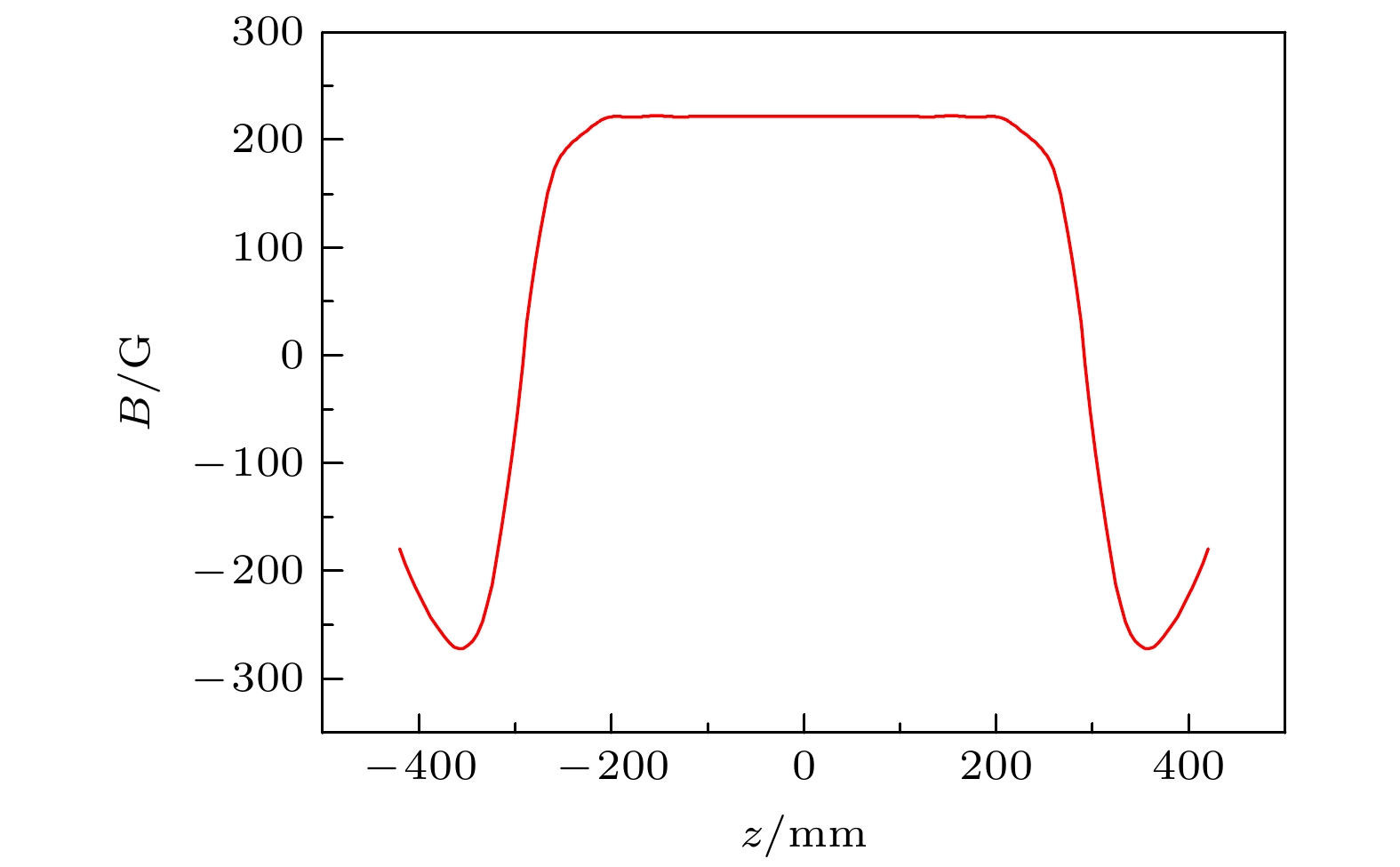-
Faraday rotation spectroscopy (FRS) is generally used to detect the concentrations of various paramagnetic trace gases because of its high detection sensitivity, zero background noise and the ability to get rid of the interference of diamagnetic materials effectively. In most of FRS technologies, the used electromagnetic fields are produced by coils, thereby triggering off some problems such as high energy consumption and excessive heat generation. Thus the modeling and the simulation study of spatial magnetic field distribution based on the combined ring permanent magnets are carried out to establish an axially distributed homogeneous magnetic field and provide a permanent magnet-based homogeneous magnetic field along the optical axis for FRS measurement. In this simulation, the method of finite element mesh division is adopted based on basic electromagnetic relationship in Maxwell equations. By the simulation study of the magnetic field distribution of the actual Nd-Fe-B permanent magnet magnetic ring array, the physical model proves to be reliable. Basically, three methods of optimizing the permanent magnetic ring arrays. i.e. single ideal value optimization method, the multi-part single objective optimization method, and the gradient optimization method, are proposed. The single ideal value optimization method and the multiple ideal value optimization method are used to realize the optimization of magnets. However, by analyzing the two methods, it is clear that compared with the single ideal value optimization method, the multiple ideal value optimization method in which the whole region is divided into several small parts can achieve good uniformity of permanent magnet array. In this way, the third method, i.e. the gradient optimization method is used to realize the construction of a homogeneous magnetic field with a uniform central axis magnetic flux density distribution used for FRS. Finally, the standard magnetic field uniformity for measuring the quality of magnet field is suggested, and through the calculation and evaluation of the magnetic field uniformity, the optimization effects of different optimization methods are analyzed and compared with each other. And the final results about realizing a homogeneous magnetic field provide a reference for developing the FRS equipment based on permanent magnets.
-
Keywords:
- permanent magnetic rings /
- distribution of magnet /
- simulation and optimization /
- Faraday rotation spectroscopy
[1] Liu K, Lewicki R, Tittel F K 2016 Sensor. Actuat. B. Chem. 237 887
 Google Scholar
Google Scholar
[2] Boone C D, Dalby F W, Ozier I 2000 J. Chem. Phys. 113 8594
 Google Scholar
Google Scholar
[3] Hinz A, Pfeiffer J, Bohle W, Urban W 1982 Mol. Phys. 45 1131
 Google Scholar
Google Scholar
[4] Litfin G, Pollock C R, Curl R F, Tittel F K 1980 J. Chem. Phys. 72 6602
 Google Scholar
Google Scholar
[5] Gianella M, Pinto T, Wu X, Ritchie G 2017 J. Chem. Phys. 147 05420
 Google Scholar
Google Scholar
[6] Westberg J, Lathdavong L, Dion C M, Shao J, Kluczynski P, Lundqvist S, Axner O 2010 J. Quant. Spectrosc. Ra. 111 2415
 Google Scholar
Google Scholar
[7] Blake T A, Chackerian C, Podolske J R 1996 Appl. Opt. 35 973
 Google Scholar
Google Scholar
[8] Adams H, Reinert D, Kalkert P, Urban W 1984 Appl. Phys. B 34 179
 Google Scholar
Google Scholar
[9] Zhang E, Huang S, Ji Q X, Silvernagel M, Wang Y, Ward B, Sigman D, Wysocki G 2015 Sensors 15 25992
 Google Scholar
Google Scholar
[10] Fritsch T, Horstjann M, Halmer D, Sabana, Hering P, Mürtz M 2008 Appl. Phys. B 93 713
 Google Scholar
Google Scholar
[11] Kluczynski P, Lundqvist S, Westberg J, Axner O. 2011 Appl. Phys. B 103 451
 Google Scholar
Google Scholar
[12] Wang Y, Nikodem M, Zhang E, Cikach F, Barnes J, Comhair S, Dweik R A, Kao C, Wysocki G 2015 Sci. Rep. 5 9096
 Google Scholar
Google Scholar
[13] Lewicki R, Doty III J H, Curl R F, Tittel F K, Wysocki G 2009 P. Natl. Acad. Sci. USA 106 12587
 Google Scholar
Google Scholar
[14] Ganser H, Urban W, Brown J M 2003 Mol. Phys. 101 545
 Google Scholar
Google Scholar
[15] Sabana H, Fritsch T, Onana M B, Bouba O, Hering P, Mürtz M 2009 Appl. Phys. B 96 535
 Google Scholar
Google Scholar
[16] Smith J M, Bloch J C, Field R W, Steinfeld J I 1995 J. Opt. Soc. Am. B 12 964
 Google Scholar
Google Scholar
[17] Zaugg C A, Lewicki R, Day T, Curl R F, Tittle F K 2011 Conference on Quantum Sensing and Nanophotonic Devices VIII San Francisco CA, January 23–27, 2011
[18] Brumfield B, Wysocki G 2012 Opt. Express 20 29727
 Google Scholar
Google Scholar
[19] So S G, Jeng E, Wysocki G 2011 Appl. Phys. B 102 279
 Google Scholar
Google Scholar
[20] Zhao W, Fang B, Lin X, Gai Y, Zhang W, Chen W, Chen Z, Zhang H, Chen W 2018 Anal. Chem. 90 3958
 Google Scholar
Google Scholar
[21] 底楠, 赵建林, 王志兵 2009 中国激光 39 2290
 Google Scholar
Google Scholar
Di N, Zhao J L, Wang Z B 2009 Chin. J. Lasers 39 2290
 Google Scholar
Google Scholar
[22] Peng Q L, Mcmurry S M, Coey J M D 2004 J. Magn. Magn. Mater. 268 165
 Google Scholar
Google Scholar
[23] 严密, 彭晓领 2006 磁学基础与磁性材料(上卷) (杭州: 浙江大学出版社) 第10—12页
Yan M, Peng X L 2006 Fundamentals of Magnetism and Magnetic Materials (Vol. 1) (Hangzhou: Zhejiang University Press) pp10–12 (in Chinese)
[24] Sabetghadam F, Sharafatmandjoor S, Norouzi F 2009 J. Comput. Phys. 228 55
 Google Scholar
Google Scholar
-
图 4 五个磁环的实验与仿真结果 (a) 实验与仿真结果对比图; (b) 磁环体内部(z1 = 78.20 mm)和间隔(z2 = 61.64 mm)处的径向磁感应强度分布图
Figure 4. Measurement and simulation results of five magnetic rings: (a) Comparison of experimental and simulation results; (b) radial magnetic induction intensity distribution inside the ring (z1 = 78.20 mm) of the group and gap (z2 = 61.64 mm).
表 1 单理想值优化结果
Table 1. Results of single-objective optimization.
${d_{{Z_1}}}/{\text{mm}}$ ${d_{{Z_2}}}/{\text{mm}}$ ${d_{{Z_3}}}/{\text{mm}}$ ${d_{{Z_4}}}/{\text{mm}}$ ${d_{{Z_5}}}/{\text{mm}}$ ${d_{{Z_6}}}/{\text{mm}}$ –1.80 –5.10 –4.87 –6.95 0.85 7.35 表 2 单理想值优化磁环排列间隔
Table 2. Magnetic rings gaps of single-objective optimization.
Gap1/2
/mmGap2
/mmGap3
/mmGap4
/mmGap5
/mmGap6
/mm8.20 16.70 20.22 17.92 27.80 26.50 表 3 多段式单理想值优化结果
Table 3. Results of multi-part single objective optimization.
${d_{{Z_1}}}/{\text{mm}}$ ${d_{{Z_2}}}/{\text{mm}}$ ${d_{{Z_3}}}/{\text{mm}}$ ${d_{{Z_4}}}/{\text{mm}}$ ${d_{{Z_5}}}/{\text{mm}}$ ${d_{{Z_6}}}/{\text{mm}}$ –1.55 –5.17 –5.31 –7.07 0.15 7.35 表 4 多段式单理想值优化磁环排列间隔
Table 4. Magnetic rings gaps of multi-part single objective optimization.
Gap1/2/mm Gap2/mm Gap3/mm Gap4/mm Gap5/mm Gap6/mm 8.45 16.38 19.86 18.24 27.22 27.20 表 5 梯度优化结果
Table 5. Results of gradient optimization.
${d_{{Z_1}}}/{\text{mm}}$ ${d_{{Z_2}}}/{\text{mm}}$ ${d_{{Z_3}}}/{\text{mm}}$ ${d_{{Z_4}}}/{\text{mm}}$ ${d_{{Z_5}}}/{\text{mm}}$ ${d_{{Z_6}}}/{\text{mm}}$ –1.31 –3.55 –4.59 –3.40 2.18 14.04 表 6 梯度优化磁环排列间隔
Table 6. Magnetic rings gaps of gradient optimization.
Gap1/2/
/mmGap2/
mmGap3/
mmGap4/
mmGap5/
mmGap6/
mm8.45 17.76 18.96 21.19 25.58 31.86 表 7 三种优化方案的磁场均匀度结果比较
Table 7. Comparison of magnetic field uniformity of three optimization method.
优化方案 单理想值优化 多理想值优化 梯度优化 $ \zeta $(磁场均匀度) 23.236 12.793 0.027 -
[1] Liu K, Lewicki R, Tittel F K 2016 Sensor. Actuat. B. Chem. 237 887
 Google Scholar
Google Scholar
[2] Boone C D, Dalby F W, Ozier I 2000 J. Chem. Phys. 113 8594
 Google Scholar
Google Scholar
[3] Hinz A, Pfeiffer J, Bohle W, Urban W 1982 Mol. Phys. 45 1131
 Google Scholar
Google Scholar
[4] Litfin G, Pollock C R, Curl R F, Tittel F K 1980 J. Chem. Phys. 72 6602
 Google Scholar
Google Scholar
[5] Gianella M, Pinto T, Wu X, Ritchie G 2017 J. Chem. Phys. 147 05420
 Google Scholar
Google Scholar
[6] Westberg J, Lathdavong L, Dion C M, Shao J, Kluczynski P, Lundqvist S, Axner O 2010 J. Quant. Spectrosc. Ra. 111 2415
 Google Scholar
Google Scholar
[7] Blake T A, Chackerian C, Podolske J R 1996 Appl. Opt. 35 973
 Google Scholar
Google Scholar
[8] Adams H, Reinert D, Kalkert P, Urban W 1984 Appl. Phys. B 34 179
 Google Scholar
Google Scholar
[9] Zhang E, Huang S, Ji Q X, Silvernagel M, Wang Y, Ward B, Sigman D, Wysocki G 2015 Sensors 15 25992
 Google Scholar
Google Scholar
[10] Fritsch T, Horstjann M, Halmer D, Sabana, Hering P, Mürtz M 2008 Appl. Phys. B 93 713
 Google Scholar
Google Scholar
[11] Kluczynski P, Lundqvist S, Westberg J, Axner O. 2011 Appl. Phys. B 103 451
 Google Scholar
Google Scholar
[12] Wang Y, Nikodem M, Zhang E, Cikach F, Barnes J, Comhair S, Dweik R A, Kao C, Wysocki G 2015 Sci. Rep. 5 9096
 Google Scholar
Google Scholar
[13] Lewicki R, Doty III J H, Curl R F, Tittel F K, Wysocki G 2009 P. Natl. Acad. Sci. USA 106 12587
 Google Scholar
Google Scholar
[14] Ganser H, Urban W, Brown J M 2003 Mol. Phys. 101 545
 Google Scholar
Google Scholar
[15] Sabana H, Fritsch T, Onana M B, Bouba O, Hering P, Mürtz M 2009 Appl. Phys. B 96 535
 Google Scholar
Google Scholar
[16] Smith J M, Bloch J C, Field R W, Steinfeld J I 1995 J. Opt. Soc. Am. B 12 964
 Google Scholar
Google Scholar
[17] Zaugg C A, Lewicki R, Day T, Curl R F, Tittle F K 2011 Conference on Quantum Sensing and Nanophotonic Devices VIII San Francisco CA, January 23–27, 2011
[18] Brumfield B, Wysocki G 2012 Opt. Express 20 29727
 Google Scholar
Google Scholar
[19] So S G, Jeng E, Wysocki G 2011 Appl. Phys. B 102 279
 Google Scholar
Google Scholar
[20] Zhao W, Fang B, Lin X, Gai Y, Zhang W, Chen W, Chen Z, Zhang H, Chen W 2018 Anal. Chem. 90 3958
 Google Scholar
Google Scholar
[21] 底楠, 赵建林, 王志兵 2009 中国激光 39 2290
 Google Scholar
Google Scholar
Di N, Zhao J L, Wang Z B 2009 Chin. J. Lasers 39 2290
 Google Scholar
Google Scholar
[22] Peng Q L, Mcmurry S M, Coey J M D 2004 J. Magn. Magn. Mater. 268 165
 Google Scholar
Google Scholar
[23] 严密, 彭晓领 2006 磁学基础与磁性材料(上卷) (杭州: 浙江大学出版社) 第10—12页
Yan M, Peng X L 2006 Fundamentals of Magnetism and Magnetic Materials (Vol. 1) (Hangzhou: Zhejiang University Press) pp10–12 (in Chinese)
[24] Sabetghadam F, Sharafatmandjoor S, Norouzi F 2009 J. Comput. Phys. 228 55
 Google Scholar
Google Scholar
Catalog
Metrics
- Abstract views: 5954
- PDF Downloads: 92
- Cited By: 0















 DownLoad:
DownLoad:









